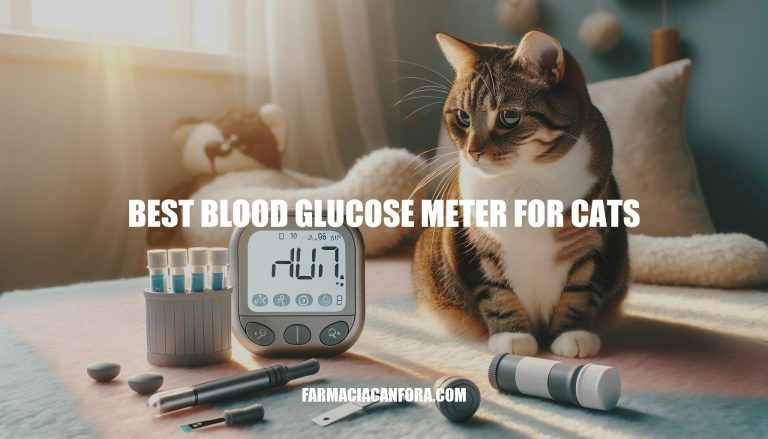Monitoring blood glucose levels in diabetic cats is crucial for their health and well-being. Finding the best blood glucose meter ensures accurate and reliable readings, helping you manage your cat’s diabetes effectively and prevent complications. Let’s explore the top options available to keep your feline friend healthy and happy.
Why Monitoring Blood Glucose in Cats is Important
Monitoring blood glucose levels in diabetic cats is crucial for several reasons:
-
Health Benefits:
- Prevents Hypoglycemia and Hyperglycemia: Regular monitoring helps maintain blood glucose within a safe range, preventing dangerous lows (hypoglycemia) and highs (hyperglycemia) that can lead to seizures, coma, or even death.
- Optimizes Insulin Therapy: Accurate readings allow for precise adjustments in insulin dosage, ensuring effective management of diabetes.
- Improves Quality of Life: Consistent monitoring helps avoid complications like nerve damage, kidney failure, and blindness, enhancing the overall well-being of the cat.
-
Potential Risks of Not Using the Best Blood Glucose Meter:
- Inaccurate Readings: Poor-quality meters can give incorrect readings, leading to inappropriate insulin dosing and increased risk of severe health issues.
- Delayed Treatment Adjustments: Without reliable data, it becomes challenging to make timely adjustments to treatment plans, potentially worsening the cat’s condition.
Using a high-quality blood glucose meter ensures accurate monitoring, which is essential for effective diabetes management and the long-term health of your cat.
Key Features to Look for in the Best Blood Glucose Meter for Cats
- Accuracy: Essential for reliable blood glucose readings, ensuring proper diabetes management.
- Ease of Use: Simple operation, quick results, and minimal blood sample required to reduce stress for both the cat and owner.
- Specific Functionalities:
- Calibrated for Cats: Meters specifically designed or calibrated for feline blood to ensure accurate readings.
- Small Blood Sample: Requires only a tiny blood sample, typically from the ear or paw pad.
- Memory Storage: Ability to store multiple readings for tracking glucose levels over time.
- User-Friendly Interface: Clear display and easy-to-navigate controls.
- Lancing Device: Includes a gentle lancing device to obtain blood samples with minimal discomfort.
- Portability: Compact and lightweight for easy handling and transport.
These features collectively ensure effective and stress-free monitoring of a cat’s blood glucose levels.
Top Recommendations for the Best Blood Glucose Meter for Cats
Here are the top recommended blood glucose meters for cats:
-
AlphaTRAK 3 Blood Glucose Monitoring Kit
- Description: Easy to use, includes a carrying case, and can be used on both cats and dogs.
- Reason: Veterinary-recommended for its accuracy and convenience.
-
Cera-Pet Blood Glucose Monitor
- Description: Offers 5% accuracy, easy to use, and includes a carrying case.
- Reason: Best value for its affordability and reliable performance.
-
Pet Control Blood Sugar Glucose Monitor
- Description: Accurate, vet-approved, and comes with easy-to-follow instructions.
- Reason: Premium choice for its high accuracy and vet approval.
-
iPet Pro Blood Glucose Monitor
- Description: Accurate, easy to use, and requires a small blood sample.
- Reason: Known for its ease of use and minimal blood sample requirement.
-
Vetmate Pet Diabetes Monitoring Kit
- Description: Accurate, easy to use, and no code-chip required.
- Reason: User-friendly and eliminates the need for code-chips.
These meters are highly recommended for their accuracy, ease of use, and overall reliability in managing your cat’s diabetes.
How to Use a Blood Glucose Meter for Cats
Here’s a step-by-step guide to using a blood glucose meter for cats:
-
Prepare the Supplies: Gather the glucose meter, test strips, lancet, cotton ball, and a treat for your cat.
-
Choose a Testing Spot: Select a quiet, comfortable area where your cat feels safe.
-
Warm the Ear: Gently rub your cat’s ear to increase blood flow. You can also use a warm cloth.
-
Insert Test Strip: Place a test strip into the glucose meter and wait for the device to signal it’s ready.
-
Clean the Ear: Wipe the inside of the ear with a cotton ball to ensure it’s clean.
-
Lance the Ear: Use the lancet to prick the edge of the ear. Aim for the vein that runs along the edge.
-
Collect Blood Sample: Touch the edge of the test strip to the blood drop. The meter will draw in the blood and start the reading.
-
Stop the Bleeding: Press a cotton ball against the ear to stop any bleeding.
-
Read and Record: Wait for the meter to display the glucose level. Record the result for your vet.
-
Reward Your Cat: Give your cat a treat and some affection to make the experience positive.
Following these steps can help ensure accurate readings and minimize stress for both you and your cat.
Choosing the Right Blood Glucose Meter for Your Cat
Managing your cat’s diabetes effectively requires a high-quality blood glucose meter that meets their specific needs. Inaccurate readings can lead to severe health issues, making it essential to select a reliable and accurate meter.
The top recommended meters include:
- The AlphaTRAK 3 Blood Glucose Monitoring Kit
- The Cera-Pet Blood Glucose Monitor
- The Pet Control Blood Sugar Glucose Monitor
- The iPet Pro Blood Glucose Monitor
- The Vetmate Pet Diabetes Monitoring Kit
These meters offer accuracy, ease of use, and reliability, making them ideal for managing your cat’s diabetes. By following the steps outlined in this guide, you can ensure accurate readings and minimize stress for both you and your cat.


